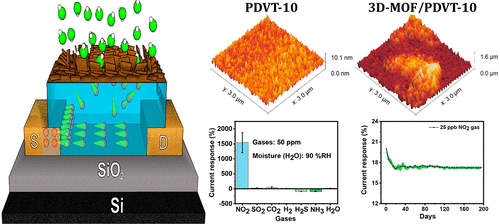

Organic field-effect transistors (OFETs) are emerging as competitive candidates for gas sensing applications due to the ease of their fabrication process combined with the ability to readily fine-tune the properties of organic semiconductors. Nevertheless, some key challenges remain to be addressed, such as material degradation, low sensitivity, and poor selectivity toward toxic gases. Appropriately, a heterojunction combination of different sensing layers with multifunctional capabilities offers great potential to overcome these problems. Here, a novel and highly sensitive receptor layer is proposed encompassing a porous 3D metal–organic framework (MOF) based on isostructural-fluorinated MOFs acting as an NO2 specific preconcentrator, on the surface of a stable and ultrathin PDVT-10 organic semiconductor on an OFET platform. Here, with this proposed combination we have unveiled an unprecedented 700% increase in sensitivity toward NO2 analyte in contrast to the pristine PDVT-10. The resultant combination for this OFET device exhibits a remarkable lowest detection limit of 8.25 ppb, a sensitivity of 680 nA/ppb, and good stability over a period of 6 months under normal laboratory conditions. Further, a negligible response (4.232 nA/%RH) toward humidity in the range of 5%–90% relative humidity was demonstrated using this combination. Markedly, the obtained results support the use of the proposed novel strategy to achieve an excellent sensing performance with an OFET platform.
